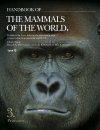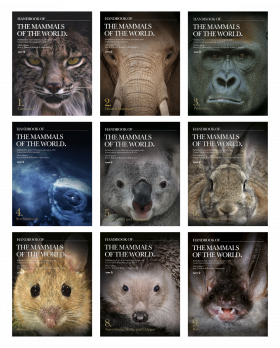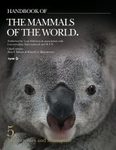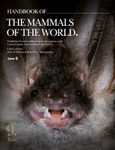By
Gehan de Silva Wijeyeratne
29 Jul 2019
Written for Hardback
This is a monster of a book at 951 pages. The third volume in the
Handbook of the Mammals of the World (HMW), it follows the general format set by the previous two volumes. But it impresses more than for just its size. It is a standard-setting book which becomes a new essential reference. It has the hallmarks which distinguished the two previous volumes of having family text written in an accessible style drawn from a comprehensive survey of the published literature combined with a stunning collection of images and a good design layout. Very few books manage this combination of being authoritative, yet accessible; of being a benchmark resource but yet with popular appeal.
I can envisage keen primate enthusiasts reading relevant family chapters before a trip. I would, for example, be certainly be reading the accounts on the Lemurs before a trip to Madagascar.
Fifty-three of the world’s leading primatologists have authored the text. Many of them are familiar names from the literature. Some time ago, I had the pleasure of working with one of them (Professor Anna Nekaris) on a guide to the Primate of Sri Lanka. Despite the huge numbers of authors, the text is consistent in style. All of the plates which illustrate every species of primate have been drawn by Stephen Nash, which is a remarkable achievement. In the second paragraph of the introduction by Russell A. Mittermeier, we learn of the story behind Nash and Anthony B. Rylands (one of the three editors with Mittermeier). Their work on primates stretches back a few decades. I first heard about Mittermeier’s work in relation to his efforts towards conservation when I attended evening classes at Birkbeck College. I suspect many readers are aware that he is a legendary figure in Zoology. The partnership with Josep Del Hoyo’s team to produce the HMW has brought together people with huge ambition and a vision to create a series where each volume is breath-taking in what it represents of human endeavour in science.
I have worked on several photographic field guides and I know only too well how even the smallest of books takes a huge amount of effort, typically spanning at least a few years. Books like this volume are epic in scale; a giant collaborative effort combing science and a design sense to celebrate humanity’s thirst for knowledge. Such is our shared genetic heritage and behaviour, it is hard not to be captivated by primates. Every page in the family accounts in the HMW is absorbing. With the volume on primates, I can dip into any paragraph and be captivated.
This publication recognises 16 families of primates. The introduction includes a table summarising the families, genera, species and taxa by region split across prosimians, monkeys and apes. A total of 681 taxa in 479 species. The book is underpinned by modern work done using molecular phylogenetics which has unearthed cryptic species. The generous word count available in a book of this size makes it especially useful for people like me who write field guides to use it as a starting point to get up to speed with current taxonomic thinking. For further reference, over 8,000 bibliographic references are provided in the end sections. The introduction provides an excellent overview, a world tour of primates in around 8 pages. I was saddened to be reminded that in Madagascar where new species of lemur continue to be found, the island has lost 90% of its original forest. Nevertheless, having grown up in Sri Lanka, I know that despite what has been lost, so much still remains in the precious little that is left.
The family sections begin with a shaded text box which has a facts at a glance summary and a world map showing distributions. The text follows standard sections with headings for Systematics, Morphological Aspects, Habitat, General Habits, Communication, Food and Feeding, Breeding, Movements, Home Range and Social Organization, Relationship with Humans, Status and Conservation followed by a general bibliography.
The headings may sound a tad dry, but as I mentioned before, it is hard not to find something interesting in every paragraph. In the very first family account, in the chapter on communication in Mouse Lemurs, we learn about cryptic alarm calls that confuse predators and furthermore that their soft trill call may suppress development of testes in subordinate males. I suspect every reader will have sections that appeal to them more than others. I find the systematics section very useful. This may be partly because I need to understand relationships because I write on natural history and also because understanding evolutionary relationships holds an intuitive appeal to me. The langurs found in India and Sri Lanka have been the subject of multiple taxonomic views and not surprisingly that particular systematics section was one of the first I looked up. In many cases, the book makes it clear that the evolutionary relationships are far from settled and further revisions are likely. I can imagine almost every primatology student would find this book a useful primer before setting off on field work to study primates with whom they have no prior familiarity.
The family accounts are followed by species accounts with a plate leading the way for several pages of text which are in smaller font and provide concise text arranged under various standard headings. These are in a style that is designed for reference rather than for a pleasurable read. It is clear that once HMW is completed, Lynx Edicions will have the text and images available for various permutations to field guides at country or regional level. These will in turn help to build capacity in many countries which still do not have good and comprehensive field guides to mammals. The plates by Nash depict all species on a plate in the same posture to allow ease of comparison. As a result, they look like ‘technical ‘drawings. On first impressions, they may seem a bit dry as they are not about showing how beautiful the animals are nor are they intended to create a plate that is lively. But the almost stylised style is very effective in what it intends to do. Plates 45 (colobus monkeys) and Plate 47 (langurs) struck me as having an almost ‘art poster’ quality to them.
It’s a magnificent work and one that holds the promise of many more exciting discoveries ahead. For a non-fiction, zoological book, it may surprise you as a book that stirs emotions, sometimes uplifting, sometimes saddening, with its interesting and exciting content for anyone who loves primates. It sets out the task ahead for conservation. We also learn for example that Sulawesi has an extraordinary diversity of tarsiers which are yet to be described. HMW Volume 3, is a guidebook to scientific adventure for young primatologists who have their careers ahead of them.


















































